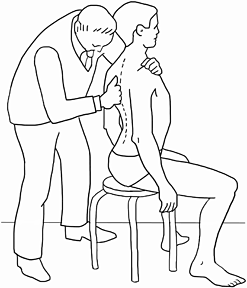
Thoracic and Lumbar



1. Body
2. Spinous prcess
3. Transverse process (TVP)
4. Pedicle
5. Vertebral foramen
6. Lamina
7. Costal facet
8. Superior facet joint
8
1
2
3
8
7

-
The thoracic portion of the spine is made up of 12 vertebrae (in green in the picture), labled as T1 through T12.
-
The thoracic portion creates the kyphotic curve in the spine.
-
Each vertabrae articulates with a rib at the costal facets.
-
Between each body of the vertebrae is a disc that absorbs impact.
-
Some key bony landmarks to easily locate and navigate from are:
-
T2 is level with the superior angle of the scapula
-
T7 is level with the interior angle of the scapula
-
T12 is level with the twelfth rib
-
BONY ANATOMY

MAJOR ORGANS OF RUQ:
Most of the liver
Right kidney
Gall bladder
MAJOR ORGANS OF THE LUQ:
Spleen
Left kidney
Pancreas
Stomach
MAJOR ORGANS OF THE LLQ:
1/2 of the bladder
1/2 of small and large intestine
MAJOR ORGANS OF THE RLQ:
1/2 of the bladder
1/2 of small and large intestine
Appendix
OTHER SOFT TISSUE ANATOMY

RHOMBOIDS
Major Origin (O): Spinous processes of 2-5th thoracic vertebrae
Major Insertion (I): Medial border of scapula between spine and inferior angle
Minor Origin: Spinous Processes of C7 and T1
Minor Insertion: Medial border at root of spine of scapula
Action (A): Adduct and elevate the scapula
LOWER TRAPEZIUS
O: Spinous Processes of T6-T12
I: Tubercle at apex of spine of scapula
A: Depresses the scapula
RECTUS ABDOMINIS
O: Pubic crest and symphysis
I: Costal cartilages of ribs 5-7, xiphoid process
A: Flexes the vertebral column by approximating the thorax and pelvis anteriorly
EXTERNAL OBLIQUES
(Anterior Fibers)
O: External surfaces of ribs 5-8
I: Linea alba by way of broad flat aponerurosis
A: Flex the vertebral column (Bilaterally)
EXTERNAL OBLIQUES
(Lateral Fibers)
O: External surface of 9th rib, external surfaces of 10-12th ribs
I: Iguinal ligament, Anterior superior spine of pubic tubercle, and external lip of iliac crest
A: Bilaterally- Flex the vertebral column. Unilaterally- Laterally flex the vertebral column approximating the thorax and iliac crest.
INTERNAL OBLIQUES
(Lower Anterior Fibers)
O: Lateral 2/3’s of inguinal ligament and iliac crest
I: Crest of pubis
A: Compress and support the lower abdominal viscera
INTERNAL OBLIQUES
(Upper Anterior Fibers)
O: Anterior 1/3 of iliac crest
I: Linea alba by means of aponeurosis
A: Bilaterally- flex the vertebral column, approximating the thorax and pelvis. Unilaterally- with the pelvis fixed, the right Internal Oblique rotates the thorax CW and the left Internal Oblique rotates the thorax CCW.
INTERNAL OBLIQUES
(Lateral Fibers)
O: Middle 1/3 of iliac crest
I: Inferior borders of 10-12th ribs
A: Bilaterally- flex the vertebral column. Unilaterally- laterally flex the vertebral column
TRANSVERSE ABDOMINIS
O: Lower 6 ribs, Anterior ¾ of iliac crest
I: Linea alba by means of aponeurosis, pubic crest
A: Acts like a girdle to flatten the abdominal wall and compress the abdominal viscera
MUSCULAR ANATOMY
LIGAMENTOUS ANATOMY
LIGAMENTUM FLAVUM
runs the length of the spine connecting at each laminae of the superior vertebrae.
INTERTRANSVERSE LIGAMENT
connects each transverse process to the superior vertebrae.
POSTERIOR LONGITUDINAL LIGAMENT
runs in the vertebral canal, connecting the vertebral bodies together. It is thickest in the thoracic region.
ANTERIOR LONGITUDINAL LIGAMENT
runs the anterior surface of the vertebral bodies, connecting them together.
INTERSPINOUS LIGAMENT
runs the posterior surface of the length of the spine, connecting the spinous processes together.
SUPRASPINOUS LIGAMENT
runs from C7 to the sacrum, connects the tips of the spinous processes together. C1-C7 is connected by the ligament nuchae.
